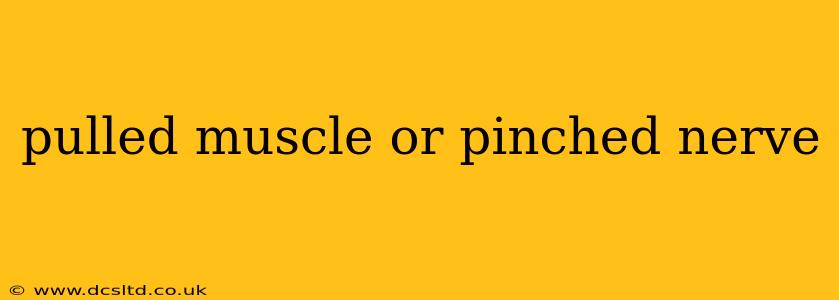Experiencing pain in your back, neck, or limbs can be debilitating. Often, the culprit is either a pulled muscle or a pinched nerve. While both conditions cause pain and discomfort, understanding their differences is crucial for effective treatment. This comprehensive guide will help you distinguish between a pulled muscle and a pinched nerve, explore their causes, symptoms, and treatment options.
What is a Pulled Muscle?
A pulled muscle, also known as a muscle strain, occurs when muscle fibers are overstretched or torn. This typically happens during sudden movements, strenuous activity, or repetitive motions. The severity of a pulled muscle can range from mild discomfort to severe pain, depending on the extent of the damage.
Symptoms of a Pulled Muscle:
- Pain: Localized pain in the affected area, often worsening with movement.
- Muscle spasms: Involuntary contractions of the muscle.
- Swelling: Inflammation around the injured muscle.
- Bruising: Discoloration of the skin may occur.
- Limited range of motion: Difficulty moving the affected area.
- Tenderness to the touch: Pain when the muscle is pressed.
What is a Pinched Nerve?
A pinched nerve, also known as a compressed nerve, happens when surrounding tissues, such as bones, muscles, tendons, or ligaments, put pressure on a nerve. This pressure can disrupt the nerve's ability to send signals, leading to pain, numbness, tingling, and weakness.
Symptoms of a Pinched Nerve:
- Pain: Sharp, shooting, or burning pain that radiates along the nerve's pathway.
- Numbness: Loss of sensation in the affected area.
- Tingling: A pins-and-needles sensation.
- Weakness: Difficulty moving or controlling the muscles supplied by the pinched nerve.
- Muscle atrophy: In severe cases, the muscles may waste away due to lack of nerve stimulation.
Pulled Muscle vs. Pinched Nerve: Key Differences
While both conditions cause pain, their nature and symptoms differ significantly. A pulled muscle typically involves localized pain and muscle dysfunction, while a pinched nerve often presents with radiating pain, numbness, tingling, and weakness along the nerve's distribution.
How to Tell if You Have a Pulled Muscle or Pinched Nerve?
Differentiating between a pulled muscle and a pinched nerve can be challenging, even for medical professionals. The location, type, and intensity of pain, along with associated symptoms like numbness or weakness, are crucial factors. A thorough physical examination by a doctor or physical therapist is usually necessary for an accurate diagnosis. They might use imaging tests like X-rays or MRIs to rule out other conditions.
What are the common causes of a pulled muscle?
Sudden strenuous activity: Lifting heavy objects, participating in intense sports, or making a quick, jerky movement can all cause muscle strains. Overexertion during exercise is a frequent culprit.
Improper warm-up: Failing to adequately prepare muscles before exercise increases the risk of strains.
Muscle imbalances: Weakness in certain muscle groups can put excessive strain on others, making them more susceptible to injury.
Dehydration: Lack of proper hydration can impair muscle function and increase the risk of strain.
What are the common causes of a pinched nerve?
Poor posture: Maintaining poor posture for prolonged periods can compress nerves, especially in the neck and back.
Repetitive movements: Performing repetitive actions at work or during hobbies can put pressure on nerves over time.
Spinal stenosis: Narrowing of the spinal canal, often caused by age-related changes, can compress nerves.
Herniated disc: A ruptured intervertebral disc can bulge and put pressure on nearby nerves.
Osteoarthritis: Degeneration of the joints can lead to bone spurs that compress nerves.
How are pulled muscles and pinched nerves treated?
Treatment for both conditions generally focuses on pain relief, reducing inflammation, and restoring function. Common treatments include:
- Rest: Avoiding activities that aggravate the pain is crucial.
- Ice: Applying ice packs to the affected area can reduce swelling and pain.
- Heat: After the initial inflammation subsides, heat can help relax muscles and improve blood flow.
- Over-the-counter pain relievers: Nonsteroidal anti-inflammatory drugs (NSAIDs) like ibuprofen or naproxen can help manage pain and inflammation.
- Physical therapy: A physical therapist can develop a tailored exercise program to strengthen muscles, improve flexibility, and restore function.
- Medication: In some cases, stronger pain relievers or muscle relaxants may be necessary.
- Corticosteroid injections: Injections of corticosteroids can reduce inflammation around a pinched nerve.
- Surgery: Surgery is rarely necessary for pulled muscles or pinched nerves, but it may be considered in severe cases that don't respond to other treatments.
When should I see a doctor for a pulled muscle or pinched nerve?
Seek immediate medical attention if you experience:
- Severe pain
- Numbness or weakness spreading to other parts of your body
- Loss of bowel or bladder control
- Inability to move your limbs
- High fever
By understanding the differences between a pulled muscle and a pinched nerve, you can better communicate with your healthcare provider and receive appropriate treatment. Remember, early diagnosis and intervention are key to preventing long-term complications. Always consult a healthcare professional for an accurate diagnosis and personalized treatment plan.
